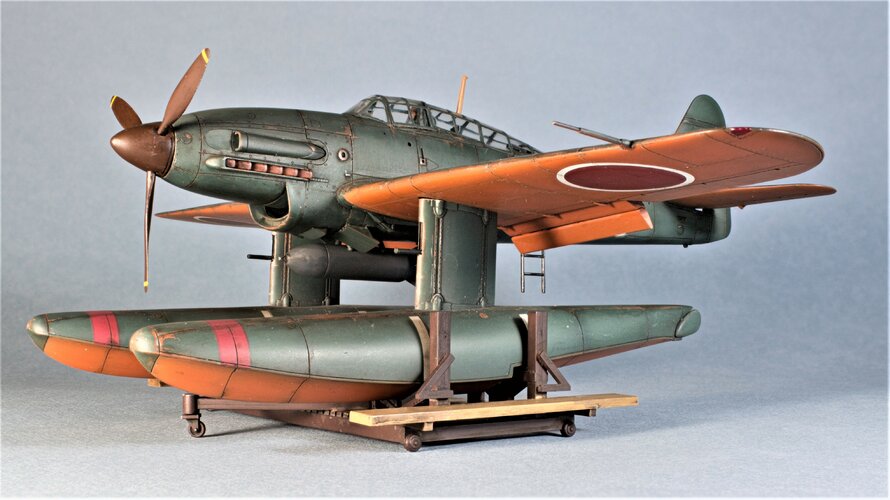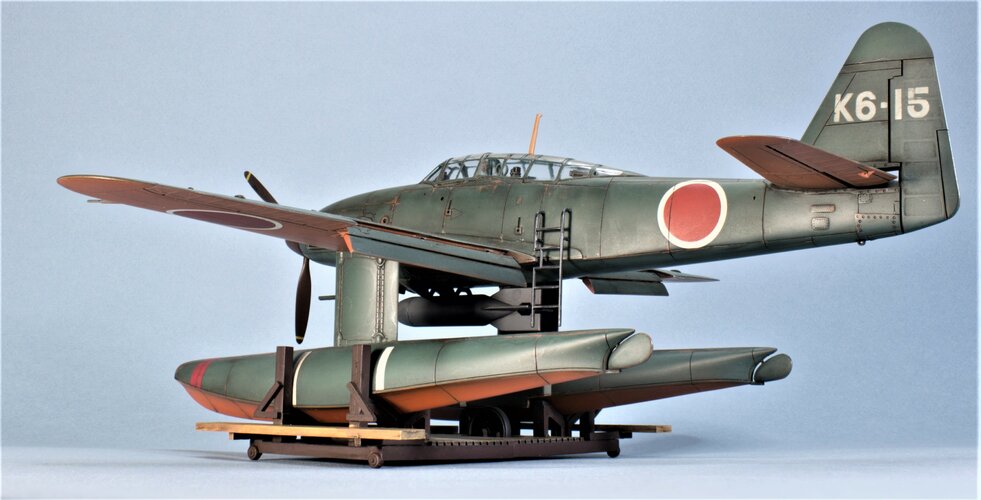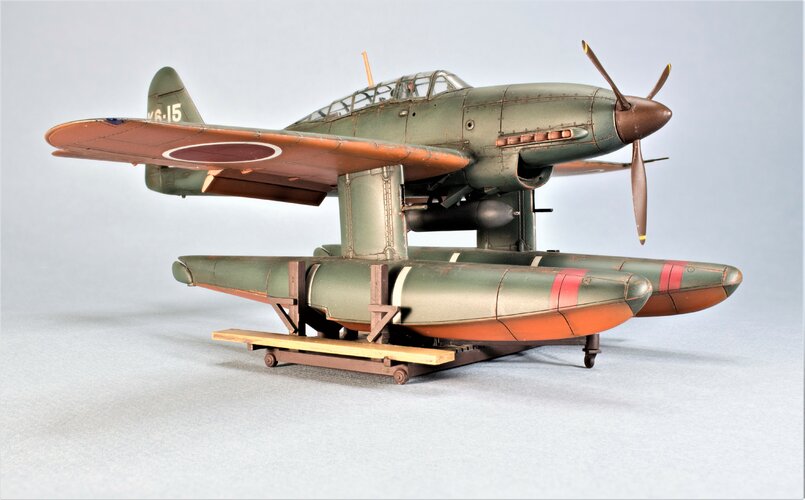You are using an out of date browser. It may not display this or other websites correctly.
You should upgrade or use an alternative browser.
You should upgrade or use an alternative browser.
Aichi M6A1 « Seiran »
- Thread starter Jemiba
- Start date
blackkite
Don't laugh, don't cry, don't even curse, but.....
- Joined
- 31 May 2007
- Messages
- 8,808
- Reaction score
- 7,684
Although there was also a proposal which adopts the converted type of a Suisei carrier bomber in early stages of this project as an attack plane of submarine loading, since it was not a seaplane, training was not completed, but it became a rejection.
The attack plane only for submarine-borne will newly be developed.
When a 250kg bomb was carried in a Seiran attack plane,catapult ejection was possible even equipped with float.
After ending of duties, when the attack of an enemy fighter is received, float is abandoned.
In that case, when it returned to a mother ship, landing into water or parachute jump is held as scheduled, the airplane was discarded and only the crew was saved.
When float was not abandoned, Seiran landed on the water near the mother ship and has collected airplanes to the mother ship.
In that case, the attack for the second time was possible.
When an enemy was attacked with an 800kg bomb or a torpedo, engine power was insufficient, and since Seiran was not able to eject from a catapult, in the state where Seiran equipped with float, it was obliged to the sortie in those without float.
In that case, when Seiran returned to a mother ship, landing into water or a parachute jump is held as scheduled, the airplane was discarded and only the crew was saved.
The attack plane only for submarine-borne will newly be developed.
When a 250kg bomb was carried in a Seiran attack plane,catapult ejection was possible even equipped with float.
After ending of duties, when the attack of an enemy fighter is received, float is abandoned.
In that case, when it returned to a mother ship, landing into water or parachute jump is held as scheduled, the airplane was discarded and only the crew was saved.
When float was not abandoned, Seiran landed on the water near the mother ship and has collected airplanes to the mother ship.
In that case, the attack for the second time was possible.
When an enemy was attacked with an 800kg bomb or a torpedo, engine power was insufficient, and since Seiran was not able to eject from a catapult, in the state where Seiran equipped with float, it was obliged to the sortie in those without float.
In that case, when Seiran returned to a mother ship, landing into water or a parachute jump is held as scheduled, the airplane was discarded and only the crew was saved.
StealthHunter
I really should change my personal text
- Joined
- 22 March 2016
- Messages
- 1
- Reaction score
- 0
"Forward-firing fixed-armament was a controversial matter, however. Originally the plane was to have one 7.7mm fixed weapon in addition to the rear flexible gun. In January 1943, the Navy felt that the mission required of this aircraft did not warrant the added weight of the fixed gun and directed that it be deleted. The need was later reconsidered by having two 20mm Type 99 Model 1, which was the Navy's most popular weapon, then considered the 20mm Type 2, all of which were to have 100 rounds each. Also contemplated were two 17mm, having 200 rounds each, but in the end, no fixed weapons were ever installed in the Seiran." - Mikesh, Robert C. Monogram Close-Up 13: Aichi M6A1 Seiran
Sorry for digging up such an old topic again, but does anyone have more information on the M6A1's proposed forward arnament? It's location on the aircraft interests me specifically, though I'd wager those guns would have been placed in the nose, similar to the D4Y1 Judy.
I'm not sure what to make of the "17mm guns" though as I can't seem to find any weapon of that caliber in the Japanese arsenal.
Sorry for digging up such an old topic again, but does anyone have more information on the M6A1's proposed forward arnament? It's location on the aircraft interests me specifically, though I'd wager those guns would have been placed in the nose, similar to the D4Y1 Judy.
I'm not sure what to make of the "17mm guns" though as I can't seem to find any weapon of that caliber in the Japanese arsenal.
StealthHunter said:...
I'm not sure what to make of the "17mm guns" though as I can't seem to find any weapon of that caliber in the Japanese arsenal.
My guess is that it is a typo for "12.7mm". I have seen the same in another book: it shows Luftwaffe personnel defending an airfield in Italy with a "17mm antiaircraft gun" that is obviously a 12.7-mm Breda aircraft gun on animprovised mount.
I see a very good explanation of Seiran kai. But the name of Seiran Kai (M6A-K) was NOT Nanzan, Nanzan was the name given to the original plan of Seiran.
According to the meeting record of the council of Seiran of Aichi, there were initially 6 seiran kai planned to be built, afterwards the plan changed to the conversion of 3 of the seiran in production. Initially the plan was to convert Seiran No4, 5, and 7 into Seiran kai, but afterwards the plan became Seiran 6, 7, and 8. In fact, all of these three were built, No.6 had a test flight in Aichi and captured by the US after the war(the photo you used was exactly No.6), No.7 was exploded as an strength experiment, No.8 was used as a trainer but not record afterwards.
Fun facts about Seiran and Seiran Kai
1. Seiran was given the Atsuda Engine (which is the same engine that used on Suisei, BF109 and He111) NOT because it could be prepared before the submarine surface, but simply because to avoid the crush between the torpedo and propeller.
2. Seiran could NOT drop her floats when taken off
3. The name "Nanzan" was abandoned NOT because it sounds like “Obstructed labour” in Japanese, but because to avoid spy activities.
4. The Seiran project was so secret that even the production routine of her blueprints (which I had carried some original ones) was also different from other planes.
5. Seiran Kai was officially classified as an "Land Based Attacker", the same classification of G4M Betty and G8N Renzan. She was the smallest land based attackers of the IJN.
6. Seiran Kai could also utilize catapult.
Information comes from the original development materials of Seiran (about 1500 pages) from Dr. Watanabe (who fixed the Seiran displayed in US).
According to the meeting record of the council of Seiran of Aichi, there were initially 6 seiran kai planned to be built, afterwards the plan changed to the conversion of 3 of the seiran in production. Initially the plan was to convert Seiran No4, 5, and 7 into Seiran kai, but afterwards the plan became Seiran 6, 7, and 8. In fact, all of these three were built, No.6 had a test flight in Aichi and captured by the US after the war(the photo you used was exactly No.6), No.7 was exploded as an strength experiment, No.8 was used as a trainer but not record afterwards.
Fun facts about Seiran and Seiran Kai
1. Seiran was given the Atsuda Engine (which is the same engine that used on Suisei, BF109 and He111) NOT because it could be prepared before the submarine surface, but simply because to avoid the crush between the torpedo and propeller.
2. Seiran could NOT drop her floats when taken off
3. The name "Nanzan" was abandoned NOT because it sounds like “Obstructed labour” in Japanese, but because to avoid spy activities.
4. The Seiran project was so secret that even the production routine of her blueprints (which I had carried some original ones) was also different from other planes.
5. Seiran Kai was officially classified as an "Land Based Attacker", the same classification of G4M Betty and G8N Renzan. She was the smallest land based attackers of the IJN.
6. Seiran Kai could also utilize catapult.
Information comes from the original development materials of Seiran (about 1500 pages) from Dr. Watanabe (who fixed the Seiran displayed in US).
Scott Kenny
ACCESS: USAP
- Joined
- 15 May 2023
- Messages
- 11,451
- Reaction score
- 13,970
Because not all the intended missions were a one-way.An interesting aircraft and an interesting concept, too, that could have had
quite a diversionary effect, probably more, than achieving actual damage.
One question remains to me, triggered partly by the picture of the Seiran with
deceptive markings : Were those floats for training purposes only ? What I read
still yet, for the actual attack, the floats would have been jettisoned and the
aircraft ditched, when coming back. But why then take-off with them at all ? And
for training I can imagine, that the floats would have quite an effect on handling
characteristics. On board of the subs, they occupied space and weight. Or doubled
they as a kind of jettisonable fuel tank ?
A sub with a couple of planes for searching out convoys is a very useful capability.
In all honesty, had the Japanese built up an attack force that was capable of messing up the Panama Canal earlier, say 1942ish, that would have bought them quite a bit more time of dominance in the Pacific.
First, it was absolutly fake that this plane could abandon her floats after taken off. She must decide whether to carry the floats BEFORE taking off. This information comes from the original blueprint and development notes that Aichi Kokuki KK's Dr.Watanabe had given me.Reading the chapter about the Aichi M6A1 Seiran/I-400 submarine in "Strike From Beneath The Sea" by Terry C. Treadwell,
I wondered, why this aircraft actually were fitted with floats ? In the mentioned book and in other sources, too, it's said,
that they should be catapulted from the submarine and jettison their floats just after take-off. Due to the nature of those
missions, it sounds very plausible to use every available way to increase speed and range. If they would ever return to their
motherships, it seems they weren't actually intended to be taken aboard again, but to be ditched alongside. Understandable,
as hoisting the aircraft, dismantling them and putting them back into their containers probably would take much longer, than
readying and launching them. And this would have to be done facing a warned enemy ! But then, why was volume, weight
and quite probably time for dismantling sacrificed for parts, that seem to have brought only disadvantages ?
Initially, just EXACTLY as you thought, Seiran was not planned to carry floats at all. Her floats was given because the IJN had also thought about using her to destroy convey ships and so on. But Seiran would only carry her floats when fighting with convey and merchant ships, she would NEVER carry floats when attacking the USN fleets. This was why Seiran had been classified as "special attack plane" and given the code M6A.
However, this does not mean that Seiran was a kamikaze plane, in fact, after the attack Seiran would land beside the submarine with her belly and the pilot would thus be recycled (Seiran has structure that allows her to not sink for a long time even if without floats)
A_Random_Guy
ACCESS: Confidential
- Joined
- 24 May 2022
- Messages
- 72
- Reaction score
- 134
Do you have any information on the range/operational radius of the aircraft? There's a frustrating number of contradictary figures online that don't specify whether their figures are total range, operational radius, and whether or not these are with floats and/or ordinance.This information comes from the original blueprint and development notes that Aichi Kokuki KK's Dr.Watanabe had given me.
I do have! let me take some time!Do you have any information on the range/operational radius of the aircraft? There's a frustrating number of contradictary figures online that don't specify whether their figures are total range, operational radius, and whether or not these are with floats and/or ordinance.
Scott Kenny
ACCESS: USAP
- Joined
- 15 May 2023
- Messages
- 11,451
- Reaction score
- 13,970
Please and thank you!I do have! let me take some time!
you guys could email me and I will give you the original blueprint and performance calculations done by aichi kokuki kk in 1944Please and thank you!
my email is: zhaoziyuan@g.ecc.u-tokyo.ac.jpPlease and thank you!
Scott Kenny
ACCESS: USAP
- Joined
- 15 May 2023
- Messages
- 11,451
- Reaction score
- 13,970
sent you an email.my email is: zhaoziyuan@g.ecc.u-tokyo.ac.jp
- Joined
- 9 October 2009
- Messages
- 21,928
- Reaction score
- 13,552
Mercenarymodeler
ACCESS: Restricted
- Joined
- 16 August 2024
- Messages
- 1
- Reaction score
- 6
Some pics of model I built sometime around 2001 or so. You can see more pics at www.mercenarymodels.com
Attachments
Scott Kenny
ACCESS: USAP
- Joined
- 15 May 2023
- Messages
- 11,451
- Reaction score
- 13,970
Oh, very nice!Some pics of model I built sometime around 2001 or so. You can see more pics at www.mercenarymodels.com
Similar threads
-
Aichi 16-Shi Navy Reconnaissance Seaplane (E16A Zuiun) (AM-22)
- Started by blackkite
- Replies: 7
-
Aichi Navy Experimental Night Reconnaissance Seaplane (AM-16)
- Started by blackkite
- Replies: 0
-
IJN Specification 12-Shi (E12/E13, Reconnaissance Seaplane, 1937)
- Started by blackkite
- Replies: 25
-
experimental ww2 Japanese aircraft radars
- Started by T-50
- Replies: 0
-
Aichi Experimental Two-Seat Reconnaissance Seaplane (AM-10)
- Started by blackkite
- Replies: 0











